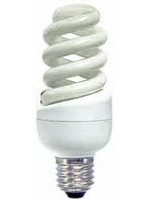 Ingredients
Ingredients-
- Argon
- Cerium
- Europium
- Lanthanum
- Mercury
- Terbium
- Yttrium
Published September 2009
In these light bulbs an electric discharge passes through argon gas containing mercury which generates UV light. This activates the coating on the inside surface of the bulb and it shines brightly. This coating includes five rare elements: cerium, europium, lanthanum, terbium and yttrium. They glow red, green, and blue, which together we perceive as white light.
Ingredients
Argon (Ar, element 18) is extracted from liquid air, of which it constitutes 1% so its supply is inexhaustible. It is completely unreactive no matter how strong the electrical discharge that is passed through it. Its most exotic use is in the tyres of luxury cars where it protects the rubber and ensures less tyre noise at high speed.
Cerium (Ce, element 58; emits green light). Its oxide is also used in catalytic converters for cars where it help metals like platinum or rhodium to remove pollutants. Thus carbon monoxide becomes CO2 and nitrogen oxides become just N2. Cerium is also part of self-cleaning ovens where it oxidises cooking resides to CO2.
Europium (Eu, element 63; emits red and blue light). If you suspect a euro note is a forgery then submit it to UV light and if parts of it glow red then it's OK. The red comes from europium in the special printing inks. Rather puzzlingly, europium was found in much higher concentrations than expected in samples of rock brought back from the Moon.
Lanthanum (La, element 57; emits green light). People suffering from chronic kidney dysfunction generally have too much phosphate in their blood, which can result in a painful bone condition. Renal dialysis does not remove phosphate effectively, but lanthanum carbonate pills will form insoluble lanthanum phosphate in the stomach so preventing any phosphate from being absorbed.
Mercury (Hg, element 80). Although mercury is an environmental toxin, the 3 mg in a low energy light bulb is less than the mercury emitted from a coal-fired power station providing the electricity to light a conventional light bulb.
Terbium (Tb, element 65; emits green light) is very rare and much more expensive than platinum. An unusual property of the terbium–iron alloy terfenol is that it will lengthen or shorten in response to a varying magnetic field. It is available as Soundbug which will turn any smooth surface like a window into a loudspeaker.
Yttrium (Y, element 39, emits red light) as yttrium oxide it is used in glass to make it heat and shock resistant, and used for camera lenses. Yttrium is used in superconductors, which conduct electricity without any loss of energy, although these still only work at very low temperatures such as that of liquid nitrogen (-183 °C). Yttrium iron garnet (YIG) can be made into large crystals for optics, while yttrium aluminium garnet (YAG) is used in lasers, and makes sparkling diamond-like gemstones.